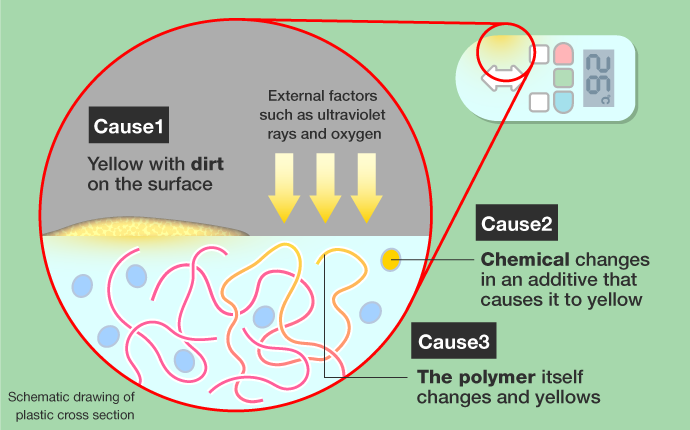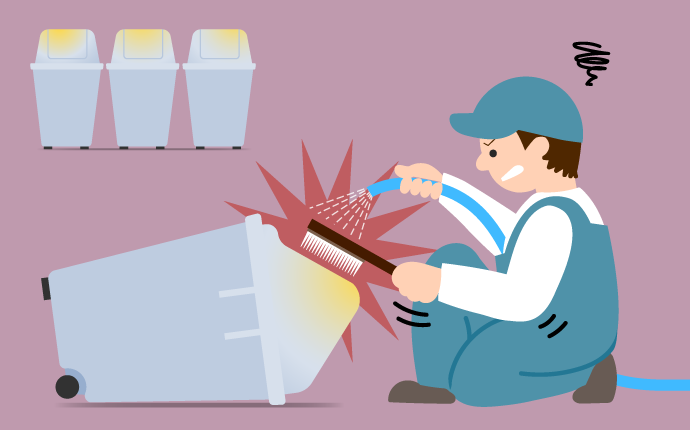What causes the yellowing of plastic?
Does it happen because it’s a macromolecule? Chemical changes consisted of one of the changes all along
As we explained in the last article, there is a lot of plastic found all around us. Plastic, like that found in air conditioner remote controls or clear smartphone cases, unexpectedly becomes yellow. Doesn’t that bother you? It happens because plastics and adhesives are macromolecules. R&D staff at ThreeBond, who are experts when it comes to macromolecules, will explain the causes of the yellowing of plastics and how to prevent that from happening.
Causes of plastic yellowing
There are many possible causes, but there are three main ones.
Cause 1: Dirt adhering to the plastic
This means cases where stains, such as those caused by oil from food or from cigarette nicotine, stick to the surface and cause it to look yellow. In this case, it is relatively easy to remove the yellowing because the plastic itself has not changed.
Cause 2: Additives in the plastic causes chemical changes
These are cases where the additives change chemically due to external factors such as ultraviolet rays and subsequently turn yellow.
As was explained in a previous article, plastics are huge macromolecule materials comprised of complexly intertwined macromolecule compounds called “polymers.” However, plastics are not formed only by polymers. They are made by mixing various additives.
That might be a bit hard to understand, so let’s compare it to curry. The main ingredients of curry are vegetables and meat, but it doesn’t become curry with these ingredients alone. The curry is complete only after various spices and seasonings are added. The same goes for plastics, which are made with additives such as “flame retardants” and “antioxidants” (akin to spices and seasonings) as well as polymers (akin to the vegetables and meat).
As you can see, additives are essential ingredients when it comes to making plastic, but they can also cause plastic to yellow. However, in the case of cause 2, it is possible to remove the yellowing because the polymer itself has not changed.
Cause 3: The structure of the polymer itself changes (aging)
This is a case where the double bonds of the polymer react with oxygen in the air and turn yellow.
A polymer called ABS resin is often used for general plastics. ABS resin has many double bonds that react well with oxygen. This double bond reacts with oxygen in the air and changes the structure of the ABS resin (polymer) itself, causing it to turn yellow.
Cause 2 and cause 3 also result in the plastic itself changing and turning yellow. In case of cause 3, the polymer itself (vegetables and meat when likening the situation to curry) changes. In this case, unlike cause 2, the main material itself becomes yellow, so it is very difficult to remove the yellowness.

Let’s fine out how to counter each cause!
Countermeasure 1: When the cause is dirt stuck to the plastic
Try soaking a melamine sponge with water and removing the dirt. If the dirt doesn’t come off easily, try using a mild detergent or baking soda to remove it. If it is still difficult, solvents such as nail polish remover are also effective. However, these can cause the plastic to melt, so be very careful and always try out a small amount first.
Countermeasure 2: When chemical changes in the additives contained in plastics occur
Bleach is effective. Soaking plastic in bleach and exposing it to ultraviolet light can remove the yellowing caused by additives such as antioxidants and flame retardants. However, these solutions are only for things that can be immersed in water.
Countermeasure 3: When the structure of the polymer itself has changed (aging)
In this case, we can first assume that it would be difficult to remove the yellowing. Instead of preventing deterioration, we propose a preventive measure that “delays” the speed of deterioration.
As explained in Cause 3, structural changes in the polymer itself are caused by the reaction of oxygen with double bonds in the polymer. So, one can expect the slowing down of the speed in which yellowing takes place through the application of a coating agent or by using a cover to prevent contact with air.
Incidentally, if you use polymers that don’t have double bonds when developing a plastic, you might end up with plastics that don’t yellow easily.

Have you gained an understanding of the factors, countermeasures, and preventive measures involved when it comes to the yellowing of plastic? Simple precautions you can take on a daily basis are to “avoid exposure of the item to sunlight” and to “put a cover on the item to prevent contact with the air.” Some people reading this may have already vaguely taken these measures. However, by properly learning about the causes, one can understand the importance of these countermeasures. Unfortunately, UV rays can reach an item even in the shade. Also, you can’t completely prevent contact with oxygen, so it’s inevitable that plastic will yellow over time. If the yellowing becomes noticeable, please try out some countermeasures to the extent possible.

